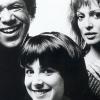Drinking From the Firehose
The Reader

Recently I was listening to Daddi’s House, my friend Bugg’s Wednesday-night Internet show on Radio Free Athens, as Bugg was interviewing members of local punkbilly outfit Grim Pickins and the Bastard Congregation. Amidst the free-floating conversation, somewhere between the on-air beer run and the question of just what the hell happened to Metallica, the topic of local rock shows came up, specifically why straight-up rock and roll seems to be foundering in this town. While a number of theories about changing audiences and current trends were batted about, one thing popped into my head: marketing, or rather the lack thereof.
Yes, it’s a given that Athens is never going to recapture the glory of its heyday in the ‘80s, when every bar in town had its doors thrown open or blown off by countless rock bands and every kid on the street was rushing between them to catch so-and-so before their set started. The lightning that struck then continues to crackle, however, and Athens remains a vibrant town for bands, artists, performers, writers, filmmakers and other creative types to practice and disseminate their respective arts.
The problem is that while art is made in a thousand different ways here, it doesn’t sell the way it should. Bands find the audiences of their friends dwindling rather than growing. Art openings are attended by other artists who come for the wine and cheese and leave empty-handed. Community theater openings attract the season-ticket holders and members of the company and still draw half-houses. Across the board, the arts community remains a closed circle with diminishing returns. The reason? Poor promotion, inadequate publicity and lazy marketing.
I love Facebook. It provides my news, my gossip, and what passes for my social life. It’s also where I find out about upcoming shows and performances around here—that is, provided I’ve been invited or happen to catch it in my news feed, and recognize any of the bands or players, or get a wild hair up my ass to click on the link. I’m one guy who happens to have an interest in supporting local artists and it’s a crapshoot to inform me of upcoming gigs. Flyers downtown are one piece of paper among hundreds of them. And much as I love this hippie socialist rag you’re reading right now, one band’s blurb in the Calendar is just not enough.
I know we’re all artists here and we’d rather be making art than hustling it, but in our current climate of information deluge, of drinking from the firehose, we have to fit our heads for an entrepreneurial hat. We have to become salesmen for our work. More importantly, we need to become marketers, constantly on the hunt for new ways to make our work stand out and take off. We may not like to think of our creative endeavors as commodities to be bought and sold, but as author Joe R. Lansdale puts it, “Hemingway cashed his checks.”
The best marketing tool, in art and music as in any other product or service, is word-of-mouth, but how do you go about generating it in our culture of constant and overwhelming noise? Fortunately Wharton professor Jonah Berger addresses this issue in his crisp, tight new book Contagious: Why Things Catch On (Simon & Schuster, 2013). This remarkable book is nothing less than a crash-course in viral marketing, and while it may not address the arts specifically, it outlines a simple but effective formula for spinning any product into widespread currency. Whether you’re selling widgets or rock operas, the book is worth picking up.
Berger’s book builds on years of research into a broad sampling of viral phenomena, many of which he recounts anecdotally here. That guy Jared who lost 250 pounds eating Subway and propelled the chain to top-tier fast-food status. The inventor of the iPad-eating blender whose YouTube videos moved thousands of units. The creator of the hundred-dollar Philly cheesesteak. Berger uses these and other examplars of the ordinary rendered extraordinary to demonstrate how the right idea can infect the social consciousness and spread when administered with keen psychological and sociological insight.
The formula Berger proposes boils down to six steps, to which he gives the acronym STEPPS: Social Currency, Triggers, Emotion, Public, Practical Value and Stories. As he outlines each component of his viral-marketing concoction, Berger offers up an array of practical examples backed with hard data that avoids dry wonkiness and steps lively. Take Kit-Kat candy bars, a perennial favorite (the jingle now resides in our DNA) that was nonetheless on the verge of extinction from a market dip a few years back. While this seems surprising, what is more startling is the market surge the product received after one marketer hit on the unusual idea of pairing Kit-Kats with coffee in an ad campaign. Berger shows how this bit of wildcat wisdom worked through the application of the principles he outlines here, which boils down to a simple rethinking of the product from the consumer’s point of view. It’s a concept all producers of goods and services should keep in mind but that bafflingly few do, fundamental as it sounds. One needn’t necessarily change the packaging, advertise it louder, or find ways to make it (ugh) “new and improved!” Ultimately, it’s not about the product; it’s about us.
Contagious is a great read, short (especially for a business-oriented book by an academic) and enjoyable throughout (ditto). More to the point, it’s a useful read with practical applications for everyone with a product to sell, and if you are an artist of any stripe, you’ve got units to move. I for one would love to see more musicians, writers, artists and creative people in this town be able to quit their day jobs. Learning to channel some of that creativity into marketing their work uniquely and effectively is a giant step in that direction.












comments